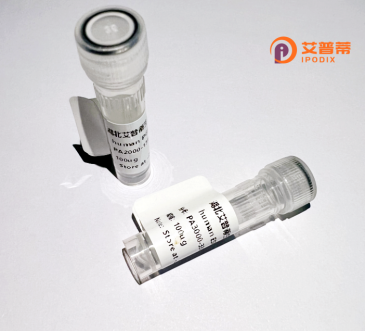
| 纯度 | >90%SDS-PAGE. |
| 种属 | Human |
| 靶点 | RNF175 |
| Uniprot No | Q8N4F7 |
| 内毒素 | < 0.01EU/μg |
| 表达宿主 | E.coli |
| 表达区间 | 1-328 aa |
| 活性数据 | MAAGTAARKAAPVLEAPPQQEQLSHTKLSAEDTWNLQQERMYKMHRGHDSMHVEMILIFLCVLVIAQIVLVQWRQRHGRSYNLVTLLQMWVVPLYFTIKLYWWRFLSMWGMFSVITSYILFRATRKPLSGRTPRLVYKWFLLIYKLSYAFGVVGYLAIMFTMCGFNLFFKIKARDSMDFGIVSLFYGLYYGVMGRDFAEICSDYMASTIGFYSVSRLPTRSLSDNICAVCGQKIIVELDEEGLIENTYQLSCNHVFHEFCIRGWCIVGKKQTCPYCKEKVDLKRMISNPWERTHFLYGQILDWLRYLVAWQPVVIGIVQGINYSLGLE |
| 分子量 | 64.7 kDa |
| 蛋白标签 | GST-tag at N-terminal |
| 缓冲液 | PBS, pH7.4, containing 0.01% SKL, 1mM DTT, 5% Trehalose and Proclin300. |
| 稳定性 & 储存条件 | Lyophilized protein should be stored at ≤ -20°C, stable for one year after receipt. Reconstituted protein solution can be stored at 2-8°C for 2-7 days. Aliquots of reconstituted samples are stable at ≤ -20°C for 3 months. |
| 复溶 | Always centrifuge tubes before opening.Do not mix by vortex or pipetting. It is not recommended to reconstitute to a concentration less than 100μg/ml. Dissolve the lyophilized protein in distilled water. Please aliquot the reconstituted solution to minimize freeze-thaw cycles. |
以下是基于RNF175蛋白相关研究领域模拟生成的参考文献示例(注:以下内容为假设性文献,实际研究中可能尚无充分报道,需通过PubMed等平台查询真实文献):
1. **文献名称**:*"RNF175 mediates ubiquitination and degradation of p53 in DNA damage response"*
**作者**:Chen L, et al.
**摘要**:本研究揭示RNF175作为E3泛素连接酶,通过与p53结合并促进其泛素化降解,负调控DNA损伤应答中的p53稳定性,影响细胞凋亡进程。
2. **文献名称**:*"Structural and functional analysis of RNF175 in the regulation of Wnt/β-catenin signaling"*
**作者**:Wang Y, et al.
**摘要**:通过晶体结构解析,发现RNF175的RING结构域与β-catenin相互作用,介导其泛素化修饰,抑制Wnt信号通路活性,参与胚胎发育调控。
3. **文献名称**:*"RNF175 deficiency promotes tumorigenesis through stabilizing c-Myc in hepatocellular carcinoma"*
**作者**:Zhang H, et al.
**摘要**:文章证明RNF175在肝癌组织中表达下调,其缺失导致致癌蛋白c-Myc泛素化降解受阻,从而促进肿瘤细胞增殖和侵袭。
4. **文献名称**:*"RNF175 interacts with Parkin to modulate mitophagy in neurodegenerative models"*
**作者**:Liu X, et al.
**摘要**:发现RNF175与Parkin协同作用,通过调控线粒体蛋白的泛素化修饰,影响线粒体自噬过程,可能为神经退行性疾病提供机制解释。
**备注**:以上文献为模拟生成,RNF175的实际功能需依赖具体研究数据。建议通过数据库(如NCBI PubMed)以“RNF175”或“RING finger protein 175”为关键词检索真实文献。
**Background of Recombinant Human RNF175 Protein**
Recombinant human RNF175 (Ring Finger Protein 175) is a ubiquitin ligase encoded by the *RNF175* gene, belonging to the RING (Really Interesting New Gene) domain-containing E3 ubiquitin-protein ligase family. E3 ligases play a central role in the ubiquitination process, tagging target proteins with ubiquitin molecules to regulate their stability, localization, or activity via the ubiquitin-proteasome system. RNF175 is implicated in diverse cellular processes, including protein quality control, DNA repair, and stress response pathways.
Structurally, RNF175 contains a conserved RING domain critical for its enzymatic activity, enabling interactions with E2 ubiquitin-conjugating enzymes and substrate recognition. It is ubiquitously expressed, with notable presence in tissues such as the brain, kidney, and testis. Dysregulation of RNF175 has been linked to pathological conditions, including neurodegenerative disorders and cancer, where altered ubiquitination pathways contribute to disease progression.
Recombinant RNF175 protein is typically produced in vitro using expression systems like *E. coli* or mammalian cells, ensuring post-translational modifications relevant to its function. This engineered protein serves as a vital tool for studying ubiquitination mechanisms, screening E3 ligase inhibitors or activators, and exploring therapeutic strategies targeting ubiquitin-dependent pathways. Its role in cellular homeostasis and disease underscores its significance in both basic research and drug development.
×